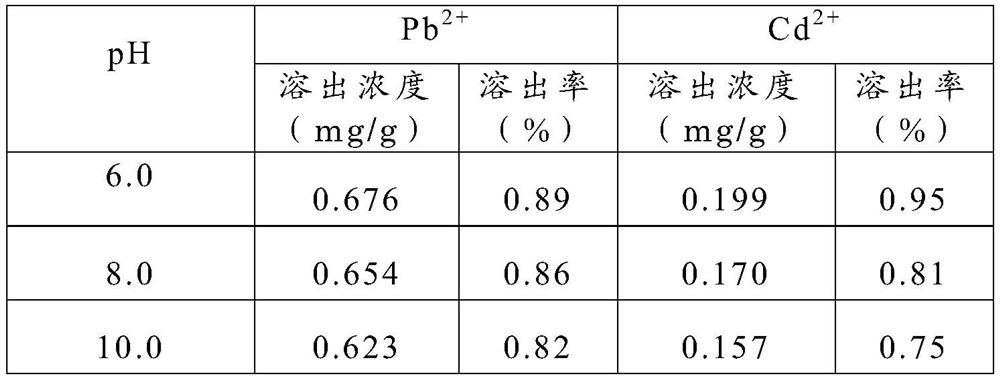An improved heavily polluted porous biochar and its preparation method
A technology of heavy pollution and biochar, applied in biofuels, chemical instruments and methods, and other chemical processes, can solve the problems of secondary pollution of soil and groundwater, heavy metals cannot be degraded by plants or biomass, and achieve mechanical properties Excellent, high porosity, large specific surface area effect
- Summary
- Abstract
- Description
- Claims
- Application Information
AI Technical Summary
Problems solved by technology
Method used
Image
Examples
preparation example Construction
[0018] In one aspect of the present invention, its object is to provide a preparation method for improving heavily polluted biochar, said method comprising:
[0019] Step 1, preparing biochar.
[0020] According to a preferred embodiment, the step 1 includes:
[0021] Step 1-1, planting plants in heavy metal polluted water or constructed wetlands;
[0022] Step 1-2, harvesting the plants planted in step 1-1 to prepare biomass;
[0023] Step 1-3, calcining the biomass obtained in step 1-2 and the passivating agent.
[0024] in particular:
[0025] In step 1-1, the plant is an aquatic plant, preferably an emergent plant, such as sagittaria, pampas grass, reed, umbrella sedge, etc., more preferably sagittaria.
[0026] According to the present invention, the emergent plants have well-developed aerenchyma and well-developed underground rhizomes or tubers, and their dredging tissues, mechanical tissues and protective tissues are well developed, and have well-developed aerenchym...
Embodiment 1
[0086] (1) Rinse the pool with clean water, then lay sand and non-polluting soil with a particle size of less than 3mm in the pool with a thickness of 20cm, fill the pool with water to 30cm, and plant 12 Arthias sagitta in the soil of the pool, After one week, adding the lead element concentration in the pond is the lead nitrate solution of 300mg / L, and the cadmium element concentration is the cadmium chloride solution of 90mg / L, uses urea (purchased from Jinan Xinyu Chengtai Chemical Technology Co., Ltd.) fertilize, and the amount of fertilization is 40g / m each time 2 , on the 120th day of Arrowhead's growth, the Arrowhead was collected, dried at a temperature of 85° C. for 3 hours, and then crushed to a size of 13 mm to obtain biomass.
[0087] (2) Crush the attapulgite to 3mm, activate it at 400°C for 2 hours, and set aside.
[0088] (3) Biomass, diatomite, natural zeolite and attapulgite (by dry weight) with a weight ratio of 1:0.3:0.4:0.35 are operated as follows:
[00...
experiment example 1
[0098] Referring to "Microwave Digestion Method of Total Heavy Metals in Soil (HJ832-2017)", accurately weigh 0.200g of the porous biochar prepared in the embodiment into a polytetrafluoroethylene digestion tank, add 9mL of concentrated nitric acid and 3mL of concentrated HCl, and let stand Allow it to react for 12 hours, and then put it into a microwave digestion apparatus for digestion to obtain a digestion solution. After the digestion is completed, transfer the digestion liquid to a 100mL volumetric flask, set the volume to the scale line, shake well and pass through a 0.45μm water filter membrane, and use ICP-OES to measure the content of heavy metal elements Pb and Cd in the filtrate, and convert to Content of heavy metals in porous biochar solids, namely: Pb 2+ The total amount of enrichment is 76mg / g, Cd 2+ The enriched total amount of 21mg / g.
PUM
| Property | Measurement | Unit |
|---|---|---|
| particle diameter | aaaaa | aaaaa |
| particle diameter | aaaaa | aaaaa |
| particle diameter | aaaaa | aaaaa |
Abstract
Description
Claims
Application Information
 Login to View More
Login to View More - R&D
- Intellectual Property
- Life Sciences
- Materials
- Tech Scout
- Unparalleled Data Quality
- Higher Quality Content
- 60% Fewer Hallucinations
Browse by: Latest US Patents, China's latest patents, Technical Efficacy Thesaurus, Application Domain, Technology Topic, Popular Technical Reports.
© 2025 PatSnap. All rights reserved.Legal|Privacy policy|Modern Slavery Act Transparency Statement|Sitemap|About US| Contact US: help@patsnap.com



